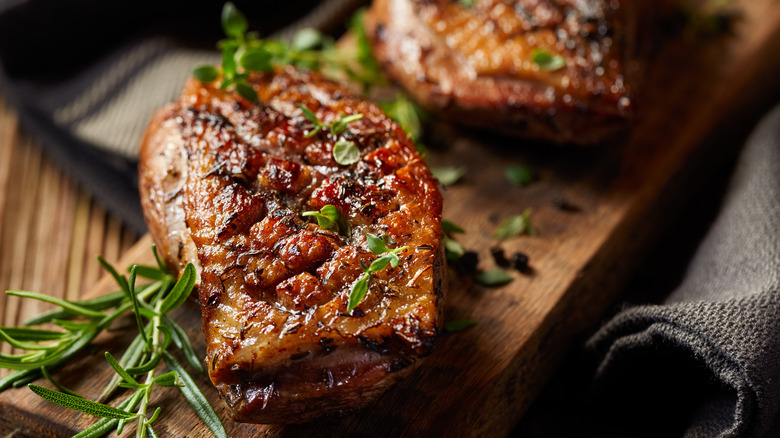Why You Don't Need To Add Oil Before Roasting Duck
It's easy to think that roasting a duck and roasting a chicken are one and the same, but the same cooking methods cannot be equally applied to these two completely different birds. A perfect example is prepping their respective skins: When roasting chicken, giving it a good coating in oil or butter is one of the keys to a crispy and flavorful skin. With a duck, however, you don't need to add any oil to the skin before roasting — its structure makes adding fats unnecessary.
Why? Well, if you were to do a cross-section of a chicken and duck, you would immediately see how much thicker the duck's skin is. This is because ducks are waterfowl and spend much of their lives on water; the thicker fat found beneath their skin helps keep them afloat. A chicken still has a layer of fat beneath its skin, but not nearly as much, which is why its skin needs to be helped along with extra fats when roasting.
Since duck skin is already so filled with fat, it's totally unnecessary to introduce more. A good amount of fat will render on its own as the duck roasts. It will, in essence, self-baste so that the skin ends up crispy while the inside remains moist and tender. But don't think just because you're not adding oil or butter that you don't have to do anything to prep a duck skin — it still needs a little help for perfect, delicious results.
Tricks for crispy duck skin
In our own recipe for crispy roast duck, we don't add anything to the skin except additional seasonings of salt and pepper. We also score the skin, which is key — neglecting to score or pierce the fat in any way means that the fat won't render completely, meaning you'll be left with soggy skin and overly greasy meat. Once the duck is in the oven, however, there are a few additional ways to end up with crispy skin.
The easiest is to place a small rack inside of your roasting pan and roast the duck breast-side down for the first 40 minutes of the roast. This will help cook the bird more evenly, and the fat will drip directly from the skin into the pan below. You can flip the duck over for the final half of the roast to let the skin crisp up.
A similar principle applies to cooking duck breasts or legs on the stove. Cook in a dry pan, skin side down, for as long as possible, flipping only once for maximum crispiness. Note that this dry pan method doesn't really work for chicken because of its lack of fat and general thinness of its skin. Instead, you might actually want to think about swapping out the oil or butter and coat your roast chicken in rendered duck, which gets you a gorgeously browned, crispy, and flavorful skin. You'll certainly have no shortage of leftover fat after your duck roast!

